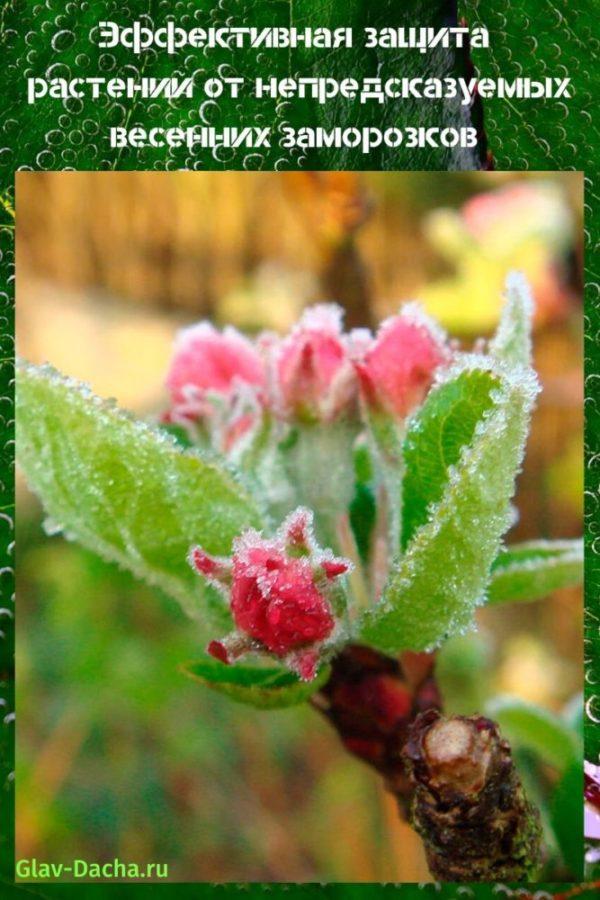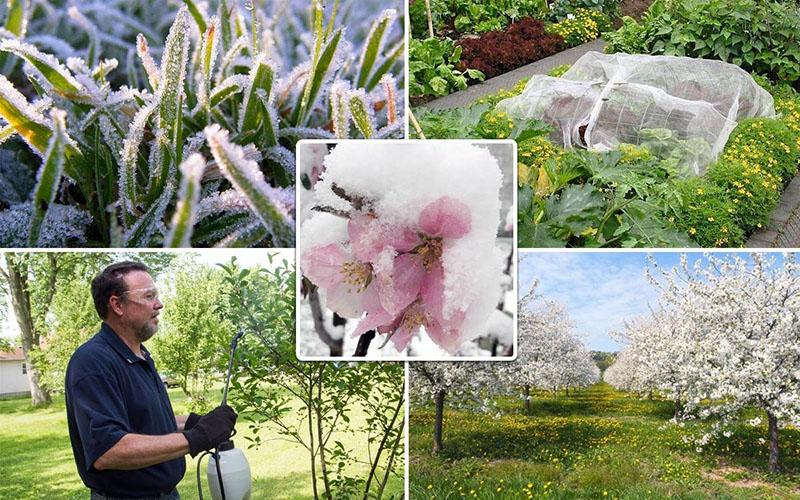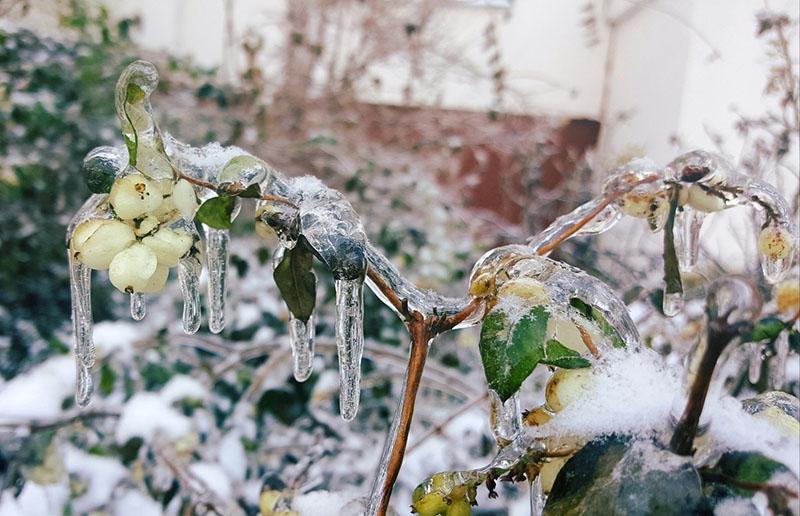Effective protection of plants against unpredictable spring frosts
 Return frosts, which occur in May and the first half of June, cause serious harm to garden and vegetable garden plants and can destroy plantations. Timely protection against spring frosts prevents the death of seedlings, shoots, ovaries and helps to save future crops.
Return frosts, which occur in May and the first half of June, cause serious harm to garden and vegetable garden plants and can destroy plantations. Timely protection against spring frosts prevents the death of seedlings, shoots, ovaries and helps to save future crops.
Types and causes of frost
 Recurrent soil frosts are a temporary decrease in air below 0 ° C. Such unpleasant weather surprises periodically occur in May and early June, causing serious harm to young shoots, leaves, buds, ovaries.
Recurrent soil frosts are a temporary decrease in air below 0 ° C. Such unpleasant weather surprises periodically occur in May and early June, causing serious harm to young shoots, leaves, buds, ovaries.
Depending on the cause of frost, they are divided into three types:
- Radiation - occur at night and are of a short-term nature. Their cause is considered to be the passage of the anticyclone, as well as the night cooling of the surface layer of the soil, warmed up by the sun's rays during the day.
- Adventure - observed most often in the second half of May due to intrusions into the territory of the Arctic air mass.
- Combined - accompanied by a periodic decrease in temperature during inclement weather, last for a long time and cover vast territories.
Combined spring and autumn frosts are considered the most dangerous for garden and vegetable garden plants. They are characterized by a decrease in air humidity, clear and calm weather - these conditions contribute to the formation of strong and prolonged frosts.
Danger of spring frost
 Return frosts are much more dangerous for garden and vegetable plantations than winter frosts. The reason why spring frosts often kill trees and crops is because the plants are dormant in winter and can easily withstand low temperatures. In the spring, the plantings begin to gradually "wake up" - the first shoots, shoots and ovaries break through, which can die from a sharp freeze.
Return frosts are much more dangerous for garden and vegetable plantations than winter frosts. The reason why spring frosts often kill trees and crops is because the plants are dormant in winter and can easily withstand low temperatures. In the spring, the plantings begin to gradually "wake up" - the first shoots, shoots and ovaries break through, which can die from a sharp freeze.
The first decade of June is the period of flowering of fruit trees and berry crops, planting of heat-loving tomatoes, eggplants, and bell peppers in open soil.
Young leaves, buds and flowers are extremely sensitive to air temperature and cannot withstand frost. The cell sap gradually freezes, causing rupture of cell membranes and their subsequent death.
What plants are afraid of frost
For effective protection against spring frosts, you need to know which plants die from a drop in air temperature and which plantings are resistant to negative weather conditions.
Do not tolerate frost:
- garden flowers and flowering annuals;

- fruit trees (especially cherry, pear, apple and peach);

- melons and gourds;
- squash;
- pumpkin;
- zucchini;
- beans;
- bell pepper;
- tomatoes.

The more the buds of the plant have blossomed, the more damage will be. At temperatures below -1 ° C, green spaces stop growing, and heat-loving tomatoes, peppers, zucchini and squash may even die.
Which plants can withstand frost
 Some plants do not need additional protection from spring frosts, as they can easily withstand temperatures down to -7-9 ° C.
Some plants do not need additional protection from spring frosts, as they can easily withstand temperatures down to -7-9 ° C.
Frost-resistant crops include:
- carrot;
- radish;
- onion;

- sorrel;
- horseradish;
- parsnip;
- White cabbage;
- rhubarb;
- spinach.
Also, dill, parsley, cilantro, lettuce and other greens.
Effective protection against spring frost
 The fight against spring frosts is carried out in various ways - with the help of sprinkling, smoke, heating, fertilizing crops, mulching, or the construction of special shelters from scrap materials.
The fight against spring frosts is carried out in various ways - with the help of sprinkling, smoke, heating, fertilizing crops, mulching, or the construction of special shelters from scrap materials.
Such methods can reduce the negative effects of frost, prevent plant death and a possible decrease in yield.
Sprinkling

Sprinkling from frost is one of the most common and effective ways to protect garden and horticultural plants. This method is used when the air temperature drops to -7 ° C.
Sprinkling, that is, watering crops, is best done late at night, several hours before the expected drop in temperature. For irrigation, use a stationary system with sprayers or a watering hose with a suitable nozzle.
With a decrease in temperature, moisture begins to gradually evaporate and warm the air, as a result, frost does not fall to the soil surface. To improve efficiency, you can line the soil around green spaces or the crown of a tree with plastic wrap immediately after irrigation. Before cooling, the film should be removed - warm vapors begin to rise up, protecting the plants.
Smoke
 One of the ways how to save plants from spring frosts is smoke. This method is considered one of the most laborious, therefore it is rarely used by gardeners and gardeners. Smoke increases the air temperature by only a few degrees, so this method is used only in frosts down to -3 ° C.
One of the ways how to save plants from spring frosts is smoke. This method is considered one of the most laborious, therefore it is rarely used by gardeners and gardeners. Smoke increases the air temperature by only a few degrees, so this method is used only in frosts down to -3 ° C.
The essence of smoke is in the placement of a row of fires from the leeward side of the site. They should be located at a distance of 3-4 m from each other, at the rate of 1 fire per hundred square meters. You can set fire to cut grass, leaves, straw, brushwood, potato tops, dry tree branches.
The basic rule is that the material used should smolder for a long time, and not instantly burn out.
The fire should be large so that it does not go out in the middle of the night - its width should be at least 130-150 cm, and its height up to 50-60 cm. It should be positioned in such a way that the smoke spreads throughout the entire treated area.
The main difficulty of the method is that it is very difficult to keep fires on the site, especially in windy weather, because they have to smoke until the morning. In addition, neighbors in the country may not like such methods of struggle.
Heating
 The heating method is used to protect plants grown in greenhouses and greenhouses.
The heating method is used to protect plants grown in greenhouses and greenhouses.
For this purpose, you need to build a kind of oven from an enameled bucket or barrel with a lid and a galvanized steel pipe:
- pour a little coal into a bucket or barrel and close it with a lid;
- make a hole in the bucket and insert a steel pipe into it;
- lead one end of the pipe out of the greenhouse and reinforce it with mineral wool.
Instead of a homemade stove, you can use heaters sold at gardening stores and gardeners. Such products are distinguished by ease of use, practicality and high cost.
Top dressing in the fight against frost
 To increase the resistance of vegetable crops to frost, phosphorus-potassium fertilizers are used.
To increase the resistance of vegetable crops to frost, phosphorus-potassium fertilizers are used.
Feeding preparation:
- 100 g of double superphosphate must be poured with 2 liters of boiling water;
- leave to infuse for 4 hours;
- pass through cheesecloth and dilute with 20 liters of water;
- add 40 g of potassium nitrate to the working solution.

Top dressing of plants is carried out by foliar method, it is best to spray it 24 hours before the expected onset of frost.
You can also make top dressing by watering at the root. This procedure is best done 10-12 hours before the expected drop in air temperature.
Mulching
 To protect vegetable crops from negative weather conditions, mulching of the beds is used. To do this, after the evening watering the crops, you need to sprinkle the beds with dried grass, compost or straw. The organic mulch layer reduces the heat transfer from the soil and increases the moisture level above the soil surface.
To protect vegetable crops from negative weather conditions, mulching of the beds is used. To do this, after the evening watering the crops, you need to sprinkle the beds with dried grass, compost or straw. The organic mulch layer reduces the heat transfer from the soil and increases the moisture level above the soil surface.
 Mulching with organic materials effectively warms the vegetable beds. An additional effect can be achieved by covering them with a layer of agrofibre - this will protect garden and vegetable plantations even from severe frosts below -8 ° C.
Mulching with organic materials effectively warms the vegetable beds. An additional effect can be achieved by covering them with a layer of agrofibre - this will protect garden and vegetable plantations even from severe frosts below -8 ° C.
Hilling bushes is excellent for protecting potato beds. To do this, young shoots are huddled with a hoe with a layer of soil up to 8-10 cm high.
Shelters for plants from scrap materials
 One of the simplest and most effective ways to protect plants from spring frosts is to use shelters organized from scrap materials.
One of the simplest and most effective ways to protect plants from spring frosts is to use shelters organized from scrap materials.
For this purpose, you can use:
- agrospan;
- lutrasil;
- sackcloth;
- spunbond;
- bottles made of plastic or glass;
- sheets of thick paper;
- polyethylene film.
 You can also make small "greenhouses" of wood, fittings or old pipes yourself. When organizing shelters, you need to ensure that the leaves and shoots of garden plants and decorative flowers do not touch the material.
You can also make small "greenhouses" of wood, fittings or old pipes yourself. When organizing shelters, you need to ensure that the leaves and shoots of garden plants and decorative flowers do not touch the material.
Protection against spring frost of garden plants
 Ways to protect trees from spring frost are similar to those used for garden plantings. The most effective are sprinkling, smoking, as well as sheltering fruit trees with improvised materials.
Ways to protect trees from spring frost are similar to those used for garden plantings. The most effective are sprinkling, smoking, as well as sheltering fruit trees with improvised materials.
One of the simplest ways of protection is to water the fruit trees with ice water from a hose with a fine spray. Externally, the tree trunk may become covered with a thin ice crust, but the cell sap does not freeze during this. When it freezes, moisture begins to evaporate and generate heat, which raises the air temperature, helping trees to preserve future crops.
There are several ways to protect garden plants from spring frosts. The most common and effective ones include sprinkling, smoke, timely feeding with phosphorus-potassium fertilizers, mulching and the construction of shelters from scrap materials. Each of these methods has its own advantages and disadvantages, so each gardener can choose the most suitable and convenient method of struggle.